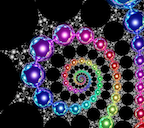Fractal Geometry

Background
"Natural" objects such as clouds, mountains, trees, snowflakes, coastlines, galaxies, plants, vascular systems, river deltas, smoke, turbulence, and percolation are not easily described with "traditional" geometry.
The geometry of the smooth and regular is called Euclidean Geometry.
The geometry of nature is called Fractal Geometry.
So What Is A Fractal?
There are quite a few definitions out there:
- A geometric figure whose parts contain the same statistical character as the whole. (OED)
- A highly irregular shape for which any suitably chosen part is similar to another larger or smaller part when magnified or reduced. (Merriam-Webster)
- An object that looks the same no matter what scale you view it at. (Ask Dr. Math)
- A set having a fractal dimension usually exceeding its topological dimension. (Wikipedia)
Self-Similarity
Self-similarity means "looks roughly the same" at different scales. We see this in nature; here zooming in on a cauliflower (from H.-O. Peitgen, J. Jürgens, and D. Saupe, Chaos and Fractals: New Frontiers of Science):

In nature, the self-similarity ends after a few orders of magnitude of zooming in. But we can give mathematical definitions with extremely simple rules that generate objects that are infinitely self-similar. Here's an introductory example:
Dimension
There are many ways to define dimension. Topologically, the dimension of a set of points is the number real numbers required to unambiguously denote a point in the set. But there's something called the fractal dimension, which this video will tell you about:
Fractal dimensions need not be integers. Many shapes with a fractal dimension strictly larger than their topological dimension are called fractals.
Fractals in Nature
Do a web search for fractals in nature and you'll find a zillion images. Or better, watch this short narrated slide show from Nicole Kershaw:
Generating Fractals
There are quite a few ways to describe (or draw) fractals.
Picture Grammars
TODOIterated Function Systems
These are described here.